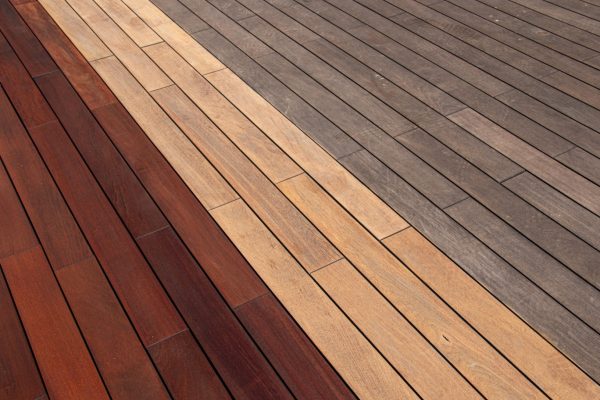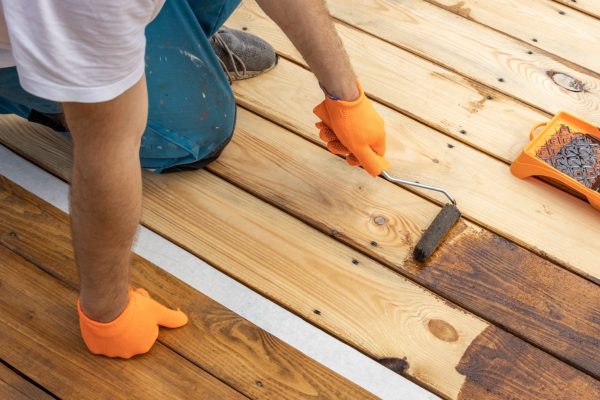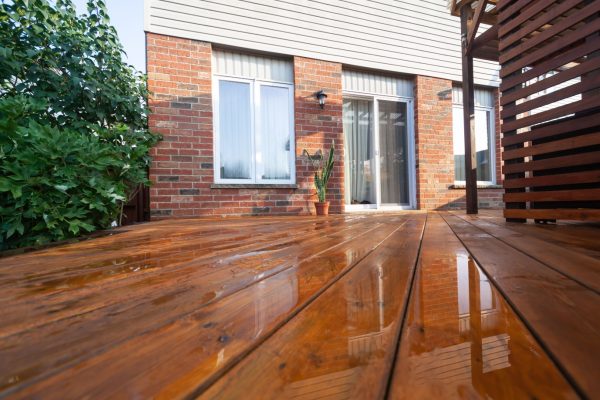Newcastle’s coastal environment exposes your deck to salt air, intense sunlight, and high humidity. A well-chosen deck stain not only enhances the beauty of the wood but also protects it against harsh coastal conditions, extending its life and reducing long-term maintenance costs.
In this guide, we explore popular stain types, colour trends specific to Newcastle’s architectural styles, and essential steps for maintaining a stunning wood deck. Whether you have an expansive outdoor space overlooking the coast or a cosy backyard deck in a leafy suburb, our guide will help you choose the perfect stain colour for your home.
Deck Stain Types and Opacity Levels
Deck stains are available in various opacity levels, each offering a distinct balance between showcasing the timber’s natural wood grain and providing protective coverage.
The right opacity can mean fewer touch-ups, greater UV protection, and a style that complements both your home and the surrounding coastal environment.
Transparent Stains
Transparent deck stains allow the inherent wood grain to shine through, celebrating the natural character of your timber. These stains are often chosen to enhance new or high-quality wood decks, where the organic beauty is desired to stand out.
However, transparent stains provide the least amount of UV protection, which can be problematic in coastal climates, where summer sun and salty air can accelerate fading. Regular reapplication may be necessary for deck maintenance, especially if your deck is exposed to direct sunlight or frequently subjected to sea spray. Despite the extra care, many homeowners find the rustic charm is well worth the effort.
Semi-Transparent Stains
Semi-transparent deck stains strike a balance between showing the wood grain and adding a hint of colour. This approach preserves much of the wood’s natural character while offering increased fade and moisture protection compared to purely transparent stains.
Given Australia’s unpredictable climate, with periods of intense humidity or storms rolling in from the coast, semi-transparent stains are a popular choice for those looking to prolong the life of their deck. They also tend to be more forgiving if you miss a maintenance cycle, requiring fewer extensive interventions to keep them looking fresh.
Semi-Solid Stains
A semi-solid stain delivers a richer colour payoff while still allowing some of the underlying wood texture to peek through. Many homeowners prefer this option if their deck has minor surface imperfections, as it evens out the overall appearance without entirely masking the wood grain.
Semi-solid stains typically require less maintenance than transparent or semi-transparent products, making them a favourite in regions with harsh climatic elements, such as coastal winds and salt-laden air.
They’re also versatile in harmonising with various exterior façades, from sleek contemporary homes to classic Aussie beach cottages.
Solid Stains
If you’re seeking maximum coverage and strong protection, a solid stain may be the ideal fit. Solid deck stains are especially helpful for older, weathered decks, as they conceal blemishes while forming a strong barrier against the region’s intense UV rays and moisture.
Unlike transparent or semi-transparent stains, a solid stain will largely obscure the wood grain, focusing more on consistent colour rather than highlighting natural patterns.
Due to its sturdy, paint-like finish, this option is often chosen for deck restoration projects aiming for dramatic transformations, such as covering a patchy or unevenly aged wood deck.

Popular Deck Stain Colours
In coastal cities, certain trends emerge as homeowners adapt their choices to suit both the environment and popular Australian design aesthetics.
While personal preference is important, local climate, house styles, and the surrounding scenery also play key roles in deciding the best stain colours for your outdoor space.
Natural and Honey Tones
Natural or honey-coloured stains remain popular in Australian coastal communities. These light-toned stains highlight the inherent beauty of timber and seamlessly blend with the relaxed, beachy atmosphere of Newcastle. Honey tones suit various architectural styles, from modern beach houses to classic weatherboard cottages, and bring warmth to any outdoor space.
Additionally, lighter stains can help reduce heat absorption—a benefit for those hot Aussie summers. Regular maintenance will still be necessary, but the payoff is a timeless look that beautifully highlights the wood grain of your deck.
Rich Brown and Cedar Tones
Deep browns, including classic cedar shades, offer a sophisticated look that’s also highly practical. Dark brown stains are particularly popular among Newcastle homeowners aiming for an elegant, natural appearance that creates a strong contrast with surrounding greenery or bright coastal skies.
In terms of deck restoration, brown or cedar hues can revitalise a fading wood deck, highlighting the texture of the boards and creating an inviting focal point for social gatherings. Most importantly, these tones often exhibit good durability when facing salty air and daily weather fluctuations.
Coastal Grey Tones
Muted greys and driftwood-inspired stains blend seamlessly into Newcastle’s beachy aesthetic, evoking the soft tones of weathered timber and seaside cliffs. These shades have been on-trend for years and remain a popular choice as we enter 2025.
Grey can also be quite forgiving in terms of showing dirt or salt deposits common in a sea-facing locale, making deck maintenance straightforward. If your home boasts ocean views, a coastal grey deck can seamlessly tie together the horizon’s colours and your immediate outdoor space.
Modern Charcoal and Dark Tones
Charcoal and other deeper, bolder hues are increasingly in vogue for Newcastle decks. A dark colour creates a dramatic statement, particularly if your backyard is more contemporary in design or features sleek landscaping. These tones can make a spacious wooden deck feel luxurious and modern, but remember that darker shades tend to absorb more heat.
If you enjoy barefoot living, consider how warm the boards might get on the sunniest days. That said, choosing a solid stain in a dark hue will provide strong UV protection, helping guard your deck from wear and tear.
Red and Amber Tones
Blending perfectly with the earthy palette of native Australian flora, red and amber tones bring warmth and personality to a wood deck. They are well-suited to timbers commonly used across Australia, such as Merbau and Jarrah, which often have a natural grain and reddish undertones.
In coastal environments like Newcastle, these vibrant hues can stand out against the beach sands or lush greenery. Some caution is required, however, as intense UV rays can gradually fade red-based stains; therefore, it is wise to select a high-quality product and adhere to a regular deck maintenance schedule.
Testing and Selecting the Perfect Deck Stain Colour
Although online swatches and brand samples provide a starting point, stains can appear differently once applied to real timber. Testing is an investment in avoiding regret down the line.
Sample Testing Techniques
Begin by acquiring sample tins of your shortlisted stain colours. Apply the stain in a discreet area of the actual deck or on a leftover timber offcut that matches the species and condition of your deck. Use consistent brushstrokes, and allow each coat to dry according to the manufacturer’s recommendations.
Because deck stain can appear subtly different in varied light, check how it looks in both direct sunlight and shade. This step is key in verifying you truly love the colour before committing to the entire wood deck.
Visualising the Final Result
Think about how your deck will be used throughout the year. Is it generally a summer hub for entertaining guests under the hot Aussie sun, or is it a tranquil spot to enjoy a morning coffee? Gather family members’ opinions, and consider taking photos or short videos from different lighting angles.
Keep in mind that a semi-transparent deck stain might present more subtle shifts in colour from one coat to another, so ensuring you capture your tests carefully is essential. A bit of extra diligence now saves potential disappointment later.

Maintaining Different Stain Colours in a Coastal Environment
Once you’ve chosen and applied your deck stain, proper maintenance is crucial to preserving its vibrancy and protective qualities. Newcastle’s coastal conditions can be harsh, so proactive care will pay off in both aesthetic and longevity benefits.
Cleaning Requirements by Stain Type
Dirt, salt, leaves, and moisture all accumulate quickly in a sea-facing environment. Lighter stain colours, such as honey or grey, may show dirt and debris more visibly. However, gentle scrubbing with a mild detergent or a specialised deck cleaner, once every few months, can remove grime without harming the finish.
Darker colours can conceal superficial stains but might require close monitoring for salt build-up, which can accelerate wear. Always avoid harsh bleach-based products that can strip colour and weaken wood fibres.
Reapplication Timelines for Your Deck
The interval for re-staining varies depending on factors such as sun exposure, foot traffic, and original stain quality. Transparent and semi-transparent stains typically require reapplication more frequently—every 1–2 years—while semi-solid and solid stains can last 3–5 years under normal usage conditions.
Closer to the water’s edge, homeowners may find they need to apply sooner. Look out for signs like obvious fading, water no longer beading on the surface, or rough-textured wood boards that indicate refreshing the finish is necessary.
Top Deck Stain Products Available
Australia has no shortage of quality deck stain options, both locally made and imported products. Whether you prefer an environmentally friendly formula or a classic oil-based stain, ensure the product is labelled as suitable for exterior, coastal environments.
Water-Based Stain Options
Water-based stains dry quickly, have a relatively low odour, and allow for easy cleanup with soap and water. Many popular brands have introduced water-based formulas with advanced UV and moisture-blocking technologies designed for the Australian climate.
These products typically form a protective layer on the wood while letting the timber breathe, making them a good fit for decks in humid, salt-laden atmospheres. Some water-based stains also boast low chemical emissions, making them a healthier choice for families and pets.
Oil-Based Stain Options
Oil-based deck stains penetrate deeply into wood fibres, offering strong protection against moisture and the daily wear that can come from living near the ocean. Since they soak into the timber, they’re often praised for their ability to highlight wood grain with a warm, enriched look.
However, oil-based stains may take longer to dry and often have higher volatile organic compound (VOC) levels. For heavy-duty needs, especially on older or frequently used decks, oil-based options can provide substantial durability over time.

Professional vs. DIY Deck Staining
Staining your deck can be an enjoyable weekend project. Still, it’s not without its challenges, especially in areas like Newcastle, where atmospheric conditions and unexpected coastal weather changes can affect drying and adhesion.
When to Call the Professionals
If your deck shows severe signs of wear, such as deep cracks, soft spots, or intense staining from salt, consulting professional painting experts like Hunter Coast Painting is often wise. Professionals can correctly prep the surface, source the perfect deck stain for your wood type, and apply the stain in optimal conditions.
With local knowledge at hand, we adapt to the coastal humidity and project timing to ensure a smooth and lasting finish. Complex structures with multiple levels or railings also benefit from professional attention to detail.
Key Takeaways
- Different opacity levels offer varying protection and aesthetics: transparent stains showcase natural wood grain but provide minimal UV protection; semi-transparent strike a balance between showing grain and adding colour; semi-solid delivers richer colour while allowing some texture; and solid stains provide maximum coverage for weathered decks.
- Popular deck stain colours for 2025 include natural/honey tones that create a relaxed beachy feel; rich brown/cedar for elegance and contrast; coastal grey tones that blend with seaside aesthetics; modern charcoal for contemporary spaces; and red/amber hues that complement Australian flora.
- Testing stain samples in different lighting conditions is crucial before committing to staining an entire deck, as colours appear differently when applied to actual timber and under varied light conditions.
- Maintenance requirements vary by stain type and coastal conditions, with transparent and semi-transparent stains needing reapplication every 1-2 years, while semi-solid and solid stains can last 3-5 years, though salt exposure may accelerate wear.
Making the Right Choice
Selecting the best deck stain colours involves balancing appearance, timber protection, and local environmental challenges. In Newcastle’s coastal climate, factors like UV resistance, moisture defence, and harmonious design with the surrounding landscape all matter.
Whether you opt for a subtle semi-transparent deck stain to highlight the wood grain or a durable solid stain for tried-and-tested coverage, planning ahead and testing colours will help you love the results for years to come.
Contact Hunter Coast Painting for expert guidance on deck staining, maintenance, and restoration. Our team understands the unique demands of coastal homes and can help you create an outdoor space that’s both beautiful and long-lasting.
Share

Gavin, is the founder and director of Hunter Coast Painting who are experienced Newcastle Painters. Combining 10 years experience in the industry and having worked on multi-million dollar homes in Europe and Australia, Gavin is able to provide a wealth of knowledge and experience.

Gavin Kane
Gavin, is the founder and director of Hunter Coast Painting.
Combining 10 years experience in the industry and having worked on multi-million dollar homes in Europe and Australia, Gavin is able to provide a wealth of knowledge and experience.
